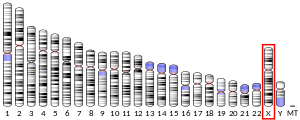RAI2
Retinoic acid-induced protein 2 is a protein that in humans is encoded by the RAI2 gene.[5][6][7]
| RAI2 | |||||||||||||||||||||||||
|---|---|---|---|---|---|---|---|---|---|---|---|---|---|---|---|---|---|---|---|---|---|---|---|---|---|
| Identifiers | |||||||||||||||||||||||||
| Aliases | RAI2, retinoic acid induced 2 | ||||||||||||||||||||||||
| External IDs | OMIM: 300217 MGI: 1344378 HomoloGene: 11034 GeneCards: RAI2 | ||||||||||||||||||||||||
| |||||||||||||||||||||||||
| |||||||||||||||||||||||||
| |||||||||||||||||||||||||
| |||||||||||||||||||||||||
| Orthologs | |||||||||||||||||||||||||
| Species | Human | Mouse | |||||||||||||||||||||||
| Entrez | |||||||||||||||||||||||||
| Ensembl | |||||||||||||||||||||||||
| UniProt | |||||||||||||||||||||||||
| RefSeq (mRNA) | |||||||||||||||||||||||||
| RefSeq (protein) |
| ||||||||||||||||||||||||
| Location (UCSC) | Chr X: 17.8 – 17.86 Mb | Chr X: 161.72 – 161.78 Mb | |||||||||||||||||||||||
| PubMed search | [3] | [4] | |||||||||||||||||||||||
| Wikidata | |||||||||||||||||||||||||
| |||||||||||||||||||||||||
Retinoic acid plays a critical role in development, cellular growth, and differentiation. The specific function of this intronless, retinoic acid-induced gene has not yet been determined; however, it has been suggested to play a role in development. Localization of this gene designates it to be a candidate for diseases such as Nance-Horan syndrome, sensorineural deafness, non-specific X-linked mental retardation, oral-facial-digital syndrome, and Fried syndrome.[7]
References
- GRCh38: Ensembl release 89: ENSG00000131831 - Ensembl, May 2017
- GRCm38: Ensembl release 89: ENSMUSG00000043518 - Ensembl, May 2017
- "Human PubMed Reference:". National Center for Biotechnology Information, U.S. National Library of Medicine.
- "Mouse PubMed Reference:". National Center for Biotechnology Information, U.S. National Library of Medicine.
- Walpole SM, Hiriyana KT, Nicolaou A, Bingham EL, Durham J, Vaudin M, Ross MT, Yates JR, Sieving PA, Trump D (May 1999). "Identification and characterization of the human homologue (RAI2) of a mouse retinoic acid-induced gene in Xp22". Genomics. 55 (3): 275–83. doi:10.1006/geno.1998.5667. PMID 10049581.
- Walpole SM, Ronce N, Grayson C, Dessay B, Yates JR, Trump D, Toutain A (Jul 1999). "Exclusion of RAI2 as the causative gene for Nance-Horan syndrome". Hum Genet. 104 (5): 410–1. doi:10.1007/s004390050976. PMID 10394933.
- "Entrez Gene: RAI2 retinoic acid induced 2".
Further reading
- Lim J, Hao T, Shaw C, et al. (2006). "A protein-protein interaction network for human inherited ataxias and disorders of Purkinje cell degeneration". Cell. 125 (4): 801–14. doi:10.1016/j.cell.2006.03.032. PMID 16713569.
- Rual JF, Venkatesan K, Hao T, et al. (2005). "Towards a proteome-scale map of the human protein-protein interaction network". Nature. 437 (7062): 1173–8. doi:10.1038/nature04209. PMID 16189514.
- Gerhard DS, Wagner L, Feingold EA, et al. (2004). "The status, quality, and expansion of the NIH full-length cDNA project: the Mammalian Gene Collection (MGC)". Genome Res. 14 (10B): 2121–7. doi:10.1101/gr.2596504. PMC 528928. PMID 15489334.
- Ota T, Suzuki Y, Nishikawa T, et al. (2004). "Complete sequencing and characterization of 21,243 full-length human cDNAs". Nat. Genet. 36 (1): 40–5. doi:10.1038/ng1285. PMID 14702039.
- Strausberg RL, Feingold EA, Grouse LH, et al. (2003). "Generation and initial analysis of more than 15,000 full-length human and mouse cDNA sequences". Proc. Natl. Acad. Sci. U.S.A. 99 (26): 16899–903. doi:10.1073/pnas.242603899. PMC 139241. PMID 12477932.
This article is issued from Wikipedia. The text is licensed under Creative Commons - Attribution - Sharealike. Additional terms may apply for the media files.




